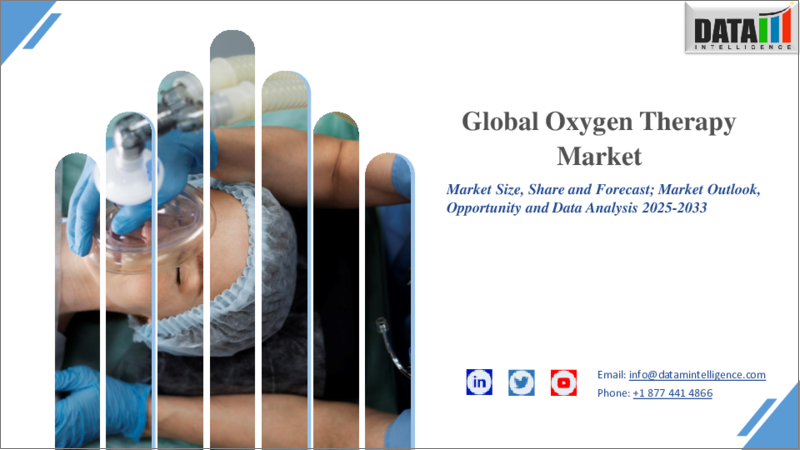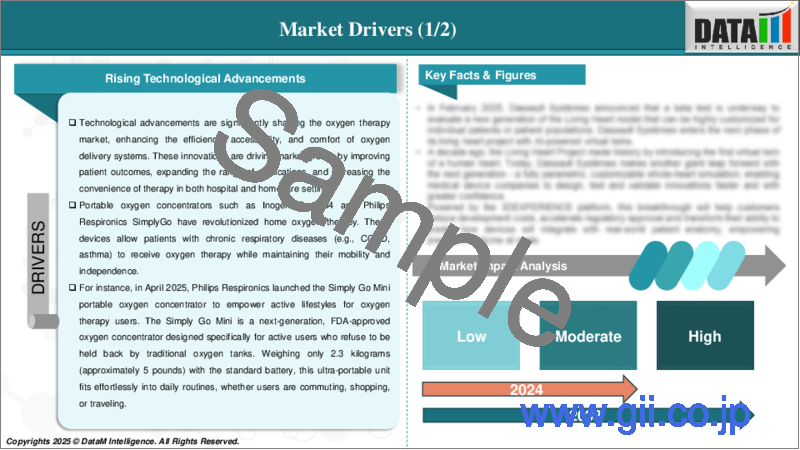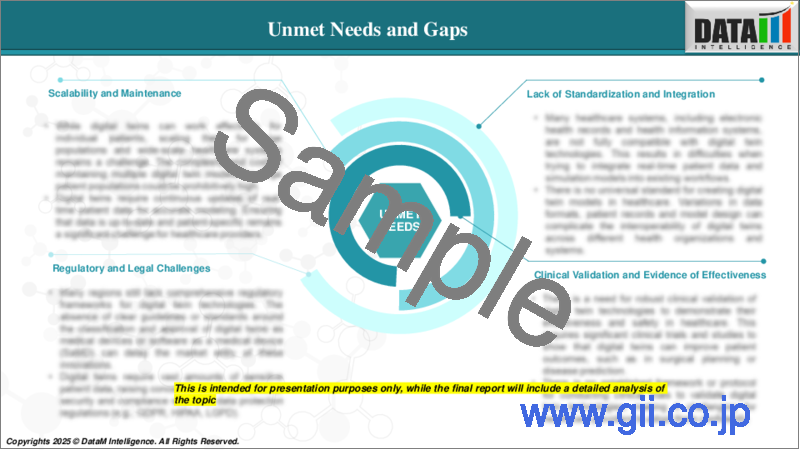|
|
市場調査レポート
商品コード
1316293
酸素療法の世界市場-2023年~2030年Global Oxygen Therapy Market - 2023-2030 |
||||||
カスタマイズ可能
適宜更新あり
|
|||||||
| 酸素療法の世界市場-2023年~2030年 |
|
出版日: 2023年07月27日
発行: DataM Intelligence
ページ情報: 英文 195 Pages
納期: 即日から翌営業日
|
- 全表示
- 概要
- 目次
市場概要
酸素療法の世界市場は2022年に296億米ドルに達し、2030年には476億米ドルに達するなど、有利な成長が予測されています。世界の酸素療法市場は予測期間(2023~2030年)にCAGR 6.3%を示すと予測されます。在宅酸素療法に対する需要の増加、軽量で携帯可能な機器へのシフト、患者の遠隔モニタリングへの注目の高まりなどが最近の市場動向です。
酸素療法の世界市場は近年継続的に拡大しています。酸素療法は、呼吸が困難な患者や血液中の酸素濃度が低い患者に酸素を補給する医療介入です。体内の様々な組織や臓器への酸素の流れを改善し、適切な機能のために十分な酸素供給を確保するために使用されます。
世界の酸素療法市場は、酸素濃縮器、酸素ボンベ、液体酸素システム、酸素マスクなど、酸素療法市場シェアを拡大させている酸素供給装置などの製品を含むコンポーネントで構成されています。酸素療法の世界市場は、呼吸器疾患の有病率の増加、高齢化人口の増加、ヘルスケア支出の増加、技術の進歩などの要因により拡大しています。
市場力学
高齢化人口の増加が酸素療法市場の成長を牽引
世界の人口は急速に高齢化しており、その結果、高齢者の呼吸器疾患の有病率が増加しています。高齢化に伴い肺機能が低下するため、酸素療法が必要となります。酸素療法機器やサービスのニーズは、特に先進国における高齢化によって高まっています。
例えば、世界保健機関(WHO)の2022年報告によると、2030年までに地球上の約6人に1人が60歳以上になると言われています。この期間内に、60歳以上の世界人口に占める割合は、2020年の10億人から14億人に増加すると予想されています。その結果、高齢化人口の増加が予測期間中の酸素療法市場の成長を促進するとみられます。
ヘルスケア支出の増加が酸素療法の世界市場における主要促進要因の1つ
ヘルスケアへの支出が世界的に増加していることは、酸素療法市場に利益をもたらしています。政府や民間ヘルスケアプロバイダーは、呼吸ケアのニーズの高まりに対応するため、酸素療法機器などの革新的な医療技術に投資しています。また、新興国における可処分所得の増加や保険適用範囲の拡大も、酸素療法への支出拡大に寄与しています。
例えば、米国国際開発庁(USAID)は2022年6月、医療用酸素への世界のアクセスを拡大するため、世界50地域のヘルスケア・インフラの建設と改善に焦点を当てた5,000万米ドルのイニシアチブを発表しました。この投資により、約2万床のベッドが整備され、毎年数十万人の患者が救命酸素を利用できるようになると期待されています。
さらに米国は、世界基金への最大のドナーであり、中低所得国における医療用酸素へのアクセスを改善するために6億米ドル以上を拠出しています。流行が始まって以来、USAIDは50カ国で酸素配給を促進するために1億1,200万米ドルの直接資金を提供してきました。こうした多額の投資は、酸素療法へのアクセス拡大へのコミットメントを示すものであり、酸素療法市場に有益な影響を与えると予測されます。
厳しい規制遵守が市場の成長を妨げる
酸素療法市場は厳しい規制によって阻害されています。例えば、2023年5月、The Pulmonary Fibrosis Foundationの医療諮問委員会は、医療専門家によって処方されたFDA承認の酸素供給機器のみを利用する必要性を強調する諮問声明を発表しました。同報告書は、処方箋なしに酸素供給機器を購入することは、重大な健康問題につながる可能性があると警告しています。
さらに、FDA非認可の酸素供給システムは信頼できる酸素供給を提供しない可能性があり、認証された機器を使用することの重要性を強調しています。これらの法律は、患者の安全性と認められたルートによる一貫した酸素療法の提供の必要性を強調することで、市場抑制要因として機能しています。
COVID-19の影響分析
COVID-19の流行は世界の酸素療法市場に深刻な影響を与えました。COVID-19患者の増加により、重度の呼吸困難に対する急性治療法である酸素療法の必要性が高まっています。その結果、酸素が不足し、酸素生産とインフラの迅速な拡張が必要となっています。
このパンデミックは、危機が去った後も呼吸器治療と適切な酸素供給の重要性を浮き彫りにしました。遠隔患者モニタリングの進歩は市場をさらに変化させました。しかし、その影響は地域によって異なっていました。全体として、COVID-19は酸素療法の重要性を浮き彫りにし、世界の業界に永遠の影響を残しました。
ロシア・ウクライナ紛争の影響分析
ロシア・ウクライナ紛争は酸素療法市場に大きな影響を与え、ヘルスケア施設を混乱させ、人口を移動させ、資源を逼迫させました。負傷、呼吸器疾患、ストレス関連の健康障害により、紛争は医療用酸素の需要を高めました。しかし、インフラの喪失やサプライチェーンの混乱により、必要とする人々に適切な酸素療法を提供することが困難になっています。
さらに、迅速な緊急対応や人道支援にリソースを割くことは、長期的なヘルスケア・インフラ整備を阻害し、包括的な酸素治療サービスを提供する能力を低下させる可能性があります。酸素療法業界への具体的な影響は、紛争の期間や激しさによって異なり、コンプライアンスを維持する上で重要な役割を果たすのは、現地のヘルスケアプロバイダーと国際支援機関です。
目次
第1章 調査手法と調査範囲
第2章 定義と概要
第3章 エグゼクティブサマリー
第4章 市場力学
- 影響要因
- 促進要因
- 呼吸器疾患の増加
- 酸素療法機器の技術進歩
- 抑制要因
- 酸素療法機器の高コスト
- 機会
- 在宅酸素療法の需要増加
- 影響分析
- 促進要因
第5章 産業分析
- ポーターの5フォース分析
- サプライチェーン分析
- 価格分析
- 規制分析
第6章 COVID-19分析
第7章 製品別
- 酸素供給装置
- 酸素供給装置
第8章 用途別
- 慢性閉塞性肺疾患
- 喘息
- 閉塞性睡眠時無呼吸症候群
- 呼吸窮迫症候群
- 嚢胞性線維症
- 肺炎
- その他
第9章 エンドユーザー別
- 病院
- 診療所
- 在宅ヘルスケア
- その他
第10章 地域別
- 北米
- 米国
- カナダ
- メキシコ
- 欧州
- ドイツ
- 英国
- フランス
- スペイン
- イタリア
- その他欧州
- 南米
- ブラジル
- アルゼンチン
- その他南米
- アジア太平洋
- 中国
- インド
- 日本
- オーストラリア
- その他アジア太平洋地域
- 中東・アフリカ
第11章 競合情勢
- 競合シナリオ
- 市況/シェア分析
- M&A分析
第12章 企業プロファイル
- GE Healthcare
- 会社概要
- 製品ポートフォリオと説明
- 財務概要
- 主な発展
- Invacare Corporation
- Inogen
- IUC Medical(Smiths Medical)
- HERSILL S.L.
- Fisher & Paykel Healthcare Limited
- Philips Respironics, Inc.
- DeVilbiss Healthcare
- Tecno-Gaz Industries
- Allied Healthcare Products, Inc.
第13章 付録
Market Overview
The global oxygen therapy market reached US$ 29.6 billion in 2022 and is projected to witness lucrative growth by reaching up to US$ 47.6 billion by 2030. The global oxygen therapy market is expected to exhibit a CAGR 6.3% during the forecast period (2023-2030). Increasing demand for homecare oxygen therapy, shift towards lightweight and portable devices, and growing focus on remote patient monitoring are some recent market trends.
The global oxygen therapy market has been expanding continuously in recent years. Oxygen therapy is a medical intervention that involves the giving of supplemental oxygen to those who have difficulty breathing or have low levels of oxygen in their blood. It is used to improve the oxygen flow to various body beings tissues and organs, ensuring enough oxygenation for appropriate functioning.
The global oxygen therapy market scope comprises components encompassing its products such as oxygen delivery devices, including oxygen concentrators, oxygen cylinders, liquid oxygen systems, and oxygen masks which has increased usage of oxygen therapy market share. The global market for oxygen therapy is expanding as a result of factors including increasing prevalence of respiratory diseases, growing aging population, rising healthcare expenditure, and technological advances.
Market Dynamics
Growing Aging Population to Drive the Growth of the Oxygen therapy Market
The global population is rapidly aging, resulting in an increased prevalence of respiratory problems among the elderly. As people age, their lung function deteriorates, necessitating the need for oxygen therapy. The need for oxygen therapy devices and services is being driven by an aging population, particularly in developed nations.
For instance, according to World Health Organization (WHO) 2022 report, by 2030, about one out of every six people on the planet will be 60 or older. Within this time span, the share of the world population aged 60 and up is expected to increase from 1 billion in 2020 to 1.4 billion. As a result, the growing aging population is expected to fuel the growth of the oxygen therapy market over the forecast period.
Increasing Healthcare Expenditure is one of the Major Driver in the Global Oxygen Therapy Market
The global increase in expenditure on healthcare has benefited the oxygen therapy market. Governments and private healthcare providers are investing in innovative medical technologies, such as oxygen therapy equipment, to address the growing need for respiratory care. Rising disposable incomes and expanded insurance coverage in emerging economies have also contributed to greater spending on oxygen therapy.
For instance, on June 2022, U.S. Agency for International Development (USAID) has announced a $50 million initiative to increase global access to medical oxygen, with a focus on the construction and improvement of healthcare infrastructure in fifty areas throughout the world. This investment is expected to support nearly 20,000 beds, allowing hundreds of thousands of patients each year to receive life-saving oxygen.
Furthermore, the U.S. is the greatest donor to The Global Fund, having contributed more than $600 million to improve access to medical oxygen in low- and middle-income nations. Since the beginning of the epidemic, USAID has provided direct funding of $112 million to boost oxygen distribution in 50 countries. These significant investments show a commitment to expanding access to oxygen therapy and are projected to have a beneficial influence on the oxygen therapy market.
The Stringent Regulatory Compliance will Hamper the Growth of the Market
The oxygen therapy market is hampered by stringent regulations. For instance, on May 2023, The Pulmonary Fibrosis Foundation's medical advisory board has issued an advisory statement emphasizing the necessity of utilizing only FDA-approved oxygen delivery equipment as prescribed by healthcare professionals. The report warns against buying oxygen supply equipment without a prescription, which might lead to significant health issues.
Furthermore, non-FDA-authorised oxygen delivery systems may not provide a reliable oxygen supply, emphasizing the importance of using certified equipment. These laws operate as market restraints by emphasizing the necessity of patient safety and the consistent delivery of oxygen therapy via recognized channels.
COVID-19 Impact Analysis
The COVID-19 epidemic severely impacted the global oxygen therapy market. The increase in COVID-19 cases increased the need for oxygen therapy, an acute treatment for severe respiratory distress. As a result, there were shortages, necessitating quick scaling of oxygen production and infrastructure.
The market saw an increase in sales and revenue, and the pandemic highlighted the significance of respiratory treatment and appropriate oxygen delivery long after the crisis had passed. Remote patient monitoring advancements altered the market even more. However, the influence differed by region. Overall, COVID-19 highlighted the importance of oxygen therapy and left an everlasting effect on the global industry.
Russia-Ukraine War Impact Analysis
The Russia-Ukraine conflict has had a major effect on the oxygen therapy market, disrupting healthcare facilities, displacing populations, and straining resources. Due to injuries, respiratory ailments, and stress-related health difficulties, the conflict has raised the demand for medical oxygen. However, infrastructure loss and disrupted supply chains have made it difficult to offer appropriate oxygen therapy to people in need.
Furthermore, allocating resources to rapid emergency response and humanitarian help may impede long-term healthcare infrastructure development, reducing the capacity to provide comprehensive oxygen treatment services. The specific impact on the oxygen therapy industry will vary depending on the length and intensity of the conflict, with local healthcare providers and international assistance organizations playing critical roles in maintaining compliance.
Segment Analysis
The global oxygen therapy market is segmented based on product, application, end user, and region.
The Chronic Obstructive Pulmonary Disorder (COPD) Segment Accounts for 31.2% of Market Share Owing to the Increasing Prevalence
The Chronic Obstructive Pulmonary Disorder (COPD) segment emerged as the market leader in oxygen therapy. COPD, a progressive lung disease characterized by airflow limitation, has a significant global impact, particularly among smokers and the elderly. COPD patients frequently require long-term oxygen therapy to enhance their oxygen levels and properly control their symptoms.
The global incidence of COPD has resulted in a significant demand for oxygen therapy devices and services tailored to this market segment. For instance, according to World Health Organization (WHO) statistics of 2023, COPD is the third leading cause of death worldwide. Furthermore, COPD has a significant impact, resulting in nearly 3.23 million deaths in 2019.
Moreover, it is worth emphasizing that low- and middle-income countries (LMICs) bear a disproportionately high burden of COPD, accounting for approximately 90% of COPD-related fatalities. Tobacco smoking is a key factor in COPD in high-income countries, accounting for more than 70% of cases. Also, with rising awareness of COPD and a growing need for respiratory assistance among affected persons, the COPD segment has established itself as the market's leading segment, driving overall growth and development.
Geographical Analysis
North America Accounted for Approximately 39.7% of the Market Share Owing to the Increasing Funding For Research Activities
North America is poised to dominate the oxygen therapy market due to rising awareness and a robust regulatory framework. For instance, companies such as Inogen, Inc. on January 2023, have gained key regulatory milestones in the EU and the US, increasing the availability and accessibility of portable oxygen concentrator equipment. This illustrates the company's dedication to providing novel respiratory treatments in the homecare sector.
Furthermore, initiatives such as Hyperbaric Knowledge USA's Hyperbaric Aware national campaign on May 2023, help to raise knowledge about hyperbaric oxygen therapy (HBOT) and its benefits. Collaboration with organizations such as the Undersea and Hyperbaric Medical Society (UHMS) and physician leaders provides vital resources for both patients and clinicians, developing a greater understanding of oxygen therapy. Thus, owing to the above factors the market is expected to grow over the forecast period.
Competitive Landscape
The major global players in the oxygen therapy market include: GE Healthcare, Invacare Corporation, Inogen, IUC Medical (Smiths Medical), HERSILL S.L., Fisher & Paykel Healthcare Limited, Philips Respironics, Inc., DeVilbiss Healthcare, Tecno-Gaz Industries, Allied Healthcare Products, Inc., and among others.
Why Purchase the Report?
- To visualize the global oxygen therapy market segmentation based on product, application, end user, and region, as well as understand key commercial assets and players.
- Identify commercial opportunities by analyzing trends and co-development.
- Excel data sheet with numerous data points of oxygen therapy market-level with all segments.
- PDF report consists of a comprehensive analysis after exhaustive qualitative interviews and an in-depth study.
- Product mapping is available as excel consisting of key products of all the major players.
The global oxygen therapy market report would provide approximately 53 tables, 54 figures and 195 Pages.
Target Audience 2023
- Manufacturers/ Buyers
- Industry Investors/Investment Bankers
- Research Professionals
- Emerging Companies
Table of Contents
1. Methodology and Scope
- 1.1. Research Methodology
- 1.2. Research Objective and Scope of the Report
2. Definition and Overview
3. Executive Summary
- 3.1. Snippet by Product
- 3.2. Snippet by Application
- 3.3. Snippet by End User
- 3.4. Snippet by Region
4. Dynamics
- 4.1. Impacting Factors
- 4.1.1. Drivers
- 4.1.1.1. Increasing Prevalence of Respiratory Disease
- 4.1.1.2. Technological Advancements in Oxygen Therapy Devices
- 4.1.2. Restraints
- 4.1.2.1. High Cost of Oxygen Therapy Equipments
- 4.1.3. Opportunity
- 4.1.3.1. Increasing Demand for Homecare Oxygen Therapy
- 4.1.4. Impact Analysis
- 4.1.1. Drivers
5. Industry Analysis
- 5.1. Porter's 5 Forces Analysis
- 5.2. Supply Chain Analysis
- 5.3. Pricing Analysis
- 5.4. Regulatory Analysis
6. COVID-19 Analysis
- 6.1. Analysis of COVID-19
- 6.1.1. Scenario Before COVID-19
- 6.1.2. Scenario During COVID-19
- 6.1.3. Scenario Post COVID-19
- 6.2. Pricing Dynamics Amid COVID-19
- 6.3. Demand-Supply Spectrum
- 6.4. Government Initiatives Related to the Market During Pandemic
- 6.5. Manufacturers Strategic Initiatives
- 6.6. Conclusion
7. By Product
- 7.1. Introduction
- 7.1.1. Market Size Analysis and Y-o-Y Growth Analysis (%), By Product
- 7.1.2. Market Attractiveness Index, By Product
- 7.2. Oxygen Source Equipment*
- 7.2.1. Introduction
- 7.2.2. Market Size Analysis and Y-o-Y Growth Analysis (%)
- 7.3. Oxygen Delivery Devices
8. By Application
- 8.1. Introduction
- 8.1.1. Market Size Analysis and Y-o-Y Growth Analysis (%), By Application
- 8.1.2. Market Attractiveness Index, By Application
- 8.2. Chronic Obstructive Pulmonary Disease*
- 8.2.1. Introduction
- 8.2.2. Market Size Analysis and Y-o-Y Growth Analysis (%)
- 8.3. Asthma
- 8.4. Obstructive Sleep Apnea
- 8.5. Respiratory Distress Syndrome
- 8.6. Cystic Fibrosis
- 8.7. Pneumonia
- 8.8. Others
9. By End User
- 9.1. Introduction
- 9.1.1. Market Size Analysis and Y-o-Y Growth Analysis (%), By End User
- 9.1.2. Market Attractiveness Index, By End User
- 9.2. Hospitals*
- 9.2.1. Introduction
- 9.2.2. Market Size Analysis and Y-o-Y Growth Analysis (%)
- 9.3. Clinics
- 9.4. Home Healthcare
- 9.5. Others
10. By Region
- 10.1. Introduction
- 10.1.1. Market Size Analysis and Y-o-Y Growth Analysis (%), By Region
- 10.1.2. Market Attractiveness Index, By Region
- 10.2. North America
- 10.2.1. Introduction
- 10.2.2. Key Region-Specific Dynamics
- 10.2.3. Market Size Analysis and Y-o-Y Growth Analysis (%), By Product
- 10.2.4. Market Size Analysis and Y-o-Y Growth Analysis (%), By Application
- 10.2.5. Market Size Analysis and Y-o-Y Growth Analysis (%), By End User
- 10.2.6. Market Size Analysis and Y-o-Y Growth Analysis (%), By Country
- 10.2.6.1. U.S.
- 10.2.6.2. Canada
- 10.2.6.3. Mexico
- 10.3. Europe
- 10.3.1. Introduction
- 10.3.2. Key Region-Specific Dynamics
- 10.3.3. Market Size Analysis and Y-o-Y Growth Analysis (%), By Product
- 10.3.4. Market Size Analysis and Y-o-Y Growth Analysis (%), By Application
- 10.3.5. Market Size Analysis and Y-o-Y Growth Analysis (%), By End User
- 10.3.6. Market Size Analysis and Y-o-Y Growth Analysis (%), By Country
- 10.3.6.1. Germany
- 10.3.6.2. U.K.
- 10.3.6.3. France
- 10.3.6.4. Spain
- 10.3.6.5. Italy
- 10.3.6.6. Rest of Europe
- 10.4. South America
- 10.4.1. Introduction
- 10.4.2. Key Region-Specific Dynamics
- 10.4.3. Market Size Analysis and Y-o-Y Growth Analysis (%), By Product
- 10.4.4. Market Size Analysis and Y-o-Y Growth Analysis (%), By Application
- 10.4.5. Market Size Analysis and Y-o-Y Growth Analysis (%), By End User
- 10.4.6. Market Size Analysis and Y-o-Y Growth Analysis (%), By Country
- 10.4.6.1. Brazil
- 10.4.6.2. Argentina
- 10.4.6.3. Rest of South America
- 10.5. Asia-Pacific
- 10.5.1. Introduction
- 10.5.2. Key Region-Specific Dynamics
- 10.5.3. Market Size Analysis and Y-o-Y Growth Analysis (%), By Product
- 10.5.4. Market Size Analysis and Y-o-Y Growth Analysis (%), By Application
- 10.5.5. Market Size Analysis and Y-o-Y Growth Analysis (%), By End User
- 10.5.6. Market Size Analysis and Y-o-Y Growth Analysis (%), By Country
- 10.5.6.1. China
- 10.5.6.2. India
- 10.5.6.3. Japan
- 10.5.6.4. Australia
- 10.5.6.5. Rest of Asia-Pacific
- 10.6. Middle East and Africa
- 10.6.1. Introduction
- 10.6.2. Key Region-Specific Dynamics
- 10.6.3. Market Size Analysis and Y-o-Y Growth Analysis (%), By Product
- 10.6.4. Market Size Analysis and Y-o-Y Growth Analysis (%), By Application
- 10.6.5. Market Size Analysis and Y-o-Y Growth Analysis (%), By End User
11. Competitive Landscape
- 11.1. Competitive Scenario
- 11.2. Market Positioning/Share Analysis
- 11.3. Mergers and Acquisitions Analysis
12. Company Profiles
- 12.1. GE Healthcare*
- 12.1.1. Company Overview
- 12.1.2. Product Portfolio and Description
- 12.1.3. Financial Overview
- 12.1.4. Key Developments
- 12.2. Invacare Corporation
- 12.3. Inogen
- 12.4. IUC Medical (Smiths Medical)
- 12.5. HERSILL S.L.
- 12.6. Fisher & Paykel Healthcare Limited
- 12.7. Philips Respironics, Inc.
- 12.8. DeVilbiss Healthcare
- 12.9. Tecno-Gaz Industries
- 12.10. Allied Healthcare Products, Inc.
LIST NOT EXHAUSTIVE
13. Appendix
- 13.1. About Us and Services
- 13.2. Contact Us






